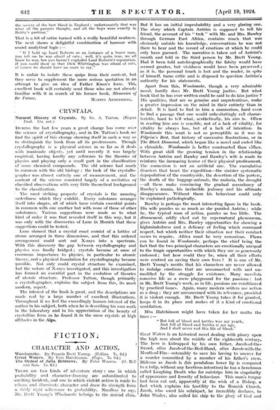CRYSTALS.
'Natural History of Crystals. By Dr. A. Tutton. (Kegan
• Paul. 15s. net.)
DURING the last few years a great change has- come over the science of crystallography, and in Dr. Tutton's book we find the spirit of this change showing itself in such a way as to distinguish the hook from all its predecessors. Though crystallography is a physical science in so far as it deals with inanimate objects, yet until recently it was largely -empirical, having hardly any referende to the theories of -physics and playing only a small part in the classification of some chemical compounds. The old science had much In common with the old biology ; the task of the crystallo- grapher was almost entirely one of measurement, and the content of the science consisted largely of a recitative of -classified observations with very little theoretical background to the classification.
The most striking property of crystals is the amazing 'orderliness which they' exhibit. Every substance arranges itself into shapes, all of which have certain essential points , 'in common with one another but with none of those of other substances. Various suggestions were made as to what kind of order it was that revealed itself in this way, but it was only with the discoveries of Lane in Munich that these suggestions could be tested.
Lane showed that a crystal must consist of a lattice of atoms arranged in three dimensiona, and that this ordered arrangement could sort out X-rays into a spectiuM. With this discovery the gap between crystallography and physics was finally bridged ; crystals became at once of enormous importance to physics, in particular to atomic theory, and a physical foundation for crystallography became 'poSsible. Not only could crystal structure be examined, but the nature Of X-rays investigated, and this investigation has formed an essential part in the evolution of theories of atomic Structure. Professor Tutton, though primarily a erYstallographer, explains the subject from this, its most modern, -aspect.
The interest of the 'hook is great, and the descriptions are made real by a large number of excellent illustrations. 'Throughout it we feel the exceedingly human interest of the author in his subject, both when he is describing his own work in the laboratory and in his appreciation of the beauty of crystalline form as he found it in the snow crystals at high altitudes in the Alps.


































 Previous page
Previous page